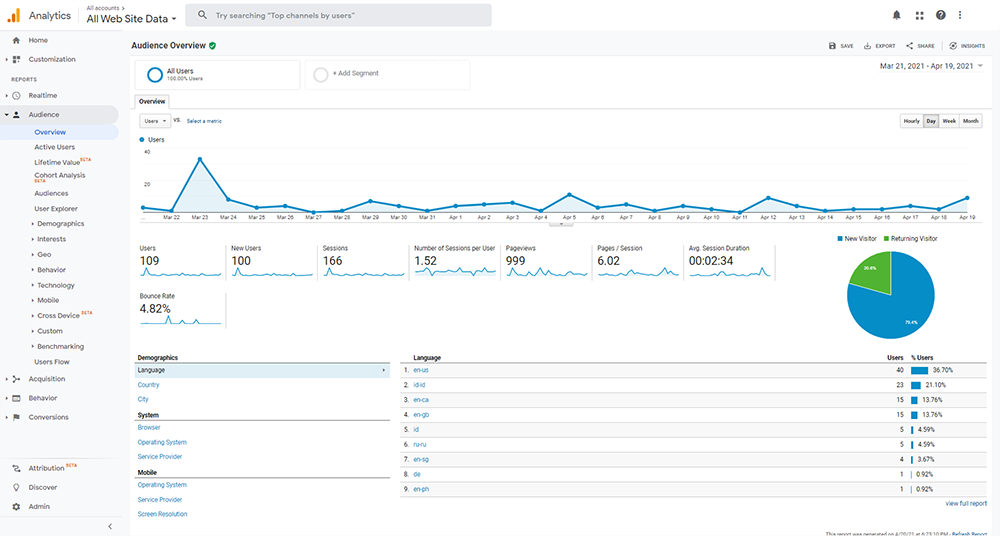A business logo is something that will appear in most of your marketing channels, including your social media accounts, flyers, and your business website. To successfully convey your brand’s identity, both your logo and business website should work in harmony and correspond with each other.
Since your logo acts as the face of your business, it needs to be effective and strong. This article will discuss the importance of a logo, the characteristics of a good logo, and what steps you need to take to create a logo that corresponds with your business website.
Why are Logos Important
A logo plays an important role in your marketing strategy. It is the visual representation of your brand identity and differentiates your business from its competitors. There are several reasons why having a logo is important for your business:
● Attention grabber: A good logo will be able to grab the attention of your potential customers quickly. It is important to have a logo that can deliver your brand message within a short period of time and invite people to know more about your business.
● Increase brand awareness: Your logo will be the extension of your brand identity. It will carry your businesses core values and story then convey them to your customers.
● Make a lasting impression: Your customers will also associate the logo with your product or service’s quality. An aesthetically pleasing logo can last longer on people’s memory compared to your business name.
Characteristics of a Good Logo
There are several characteristics that distinguish a good logo from a bad one. A logo should be:
● Distinctive: Your logo should be able to make your brand stand out and distinguishable from its competitors.
● Appropriate and Practical: A good logo should maintain its effectiveness in different sizes, color schemes, and media.
● Simple in appearance: One of the things that you should avoid when creating your logo is to make it overly complicated. Keep your logo simple and only include the essentials.
● Convey the intended meaning: Your logo is built around your brand’s core values and story. Therefore, it should be able to convey these messages to your customers.
To achieve these characteristics, there are several important steps to go through when creating your logo. Let’s take a look at what steps you need to take to make a good logo.
1. Gather Inspiration
The first step in doing any kind of creative work, including building your business website and designing the logo, is to seek inspiration. This is useful to open new perspectives and give you ideas of what element needs to be included in your design.
Many tools can help you to get fresh ideas and inspiration for your design. For logo design, look at websites such as Dribble, Behance, and Designpiration, which many artists use to showcase their design ideas and portfolios.

To get ideas for your website design, we recommend you see how other businesses within the same industry design their website. Check these website ideas to get more inspiration to make your website look attractive and professional.
The inspiration gathering process may involve brainstorming with your co-workers or business partners and writing down every idea as the base for further discussion. Remember that you open up more chances to discover a brilliant conclusion when you involve as many idea as possible.
2. Create Your Brand Identity
Creating a logo is one of the steps to develop a strong brand identity. This brand identity includes your business’s vision, what it stands for, and how you want your customers to perceive your brand.
A strong brand identity makes your business stand out among its competitors and easily recognizable. Your customers will associate your brand identity with your products and services’ quality. When your business has a positive brand identity, it will become a strong foundation for developing a good relationship with your customers.

That is why your logo’s elements should have connections to your business’s vision and origin story. Make sure to list these points before you start sketching your logo to avoid including irrelevant elements in your business logo.
Starting your brainstorming process by asking yourself questions about your business background and vision can be a good idea. Try to include questions such as what makes your business special? What are its core values? And how you want your business to be perceived?
3. Understand Your Target Audience
A target audience is the specific group of people that are most likely to purchase a product or service from a specific business. To create an effective marketing tool, you need to understand who your target audience is. There are several factors to consider when getting to know your target audience.
The first factor to look at from your target audience is demographics. Knowing your target audience’s information, including their age, gender, geographical location, and language is important for identifying their needs and preferences.

Tools such as Google Analytics can help you to track the demographic and behavior of your website’s visitors. Social media platforms like Instagram and YouTube also have their own analytics tool integrated into the account.
Another factor to consider is your target audience’s psychographics. This factor covers your audiences’ attributes such as hobbies, interests, values, and priorities. By knowing this information, you will be able to identify why they buy products or services from a certain brand.
4. Check Your Competitors
One way to create a successful marketing tool such as a business logo is to learn from what is already on the market. Competitors, especially those with bigger names, are most likely to figure out what works for their target market.
Analyze how your competition chooses to present themselves to their target audience, then take some notes about what works and what doesn’t. Important points you got from your competitors can be used as a benchmark when designing your logo.
However, even though there are established styles you need to follow for each industry type, trying something different can prove to be beneficial. Being unique can help your brand to be recognized easily and leave a more lasting impressions on your audience.
5. Choose Your Logo Design Style
As you look for inspirations and analyzing the market, you might realize that logo design comes in various styles that cater to different niches and demographics. When you choose the right style for your logo, it will convey the right characteristic.

Your business logo can be either text-based or symbol-based logo, both of which have their own pros and cons. There are also different types of visual design styles for logo design, including modern-minimalist, retro, handmade, classic, or fun.
What you need to do is to correlate your brand’s identity with one of these styles. Pick something that represents your brand the best. Don’t hesitate to mix and match different styles if you feel like it will better deliver the message and identity.
6. Choose Colors for the Logo
If you already have a color palette for your brand, choosing the color for your logo won’t be so hard. All you have to do is make sure that your logo and website use that same palette and make some adjustments if needed.
However, if you haven’t established your brand’s color, start brainstorming based on the brand identity. One important thing to know is that each color palette represents different characters and feelings, so make sure you choose the right palette to convey your message.

Don’t forget to pay attention to your target audience’s demographics when choosing your color palette. For example, if your target audience is comprised of mostly adult males, it might be a good idea to choose a calm and darker color palette.
There are tools and websites such as Color Hunt that can help you to find or brainstorm the right color combinations for your website and logo design.
7. Use the Right Font
Typography is the essential part of a text-based logos. Just like how color palettes work, different fonts also convey different character and feelings. Therefore, choosing the right font for your design should be one of your top-most priorities.
There are many types of font, but we can divide them into four main general groups, including:
● Serif fonts: Font types with small lines at the end of the letter. Serif fonts work well with classic, elegant, and vintage designs.

● Sans serif fonts: Unlike serif fonts, sans serif looks more simple and clean without the small strokes on the letters. They are widely used to convey modern and minimalistic-looking logos.

● Script fonts: This font type resembles handwritten letters with their flowy characteristic. Script fonts can help your logo feel more personal and down-to-earth.

● Display fonts: If you are looking for highly decorative fonts for your logo, these are your best choice. Use them to create a unique and eye-catching logotype.

Finding fonts to use on your business logo is easy. Numerous websites offer both paid and free fonts to download, such as Google Fonts.
8. Bring All Elements Together
After you figure out what style of logo design you want to make, it is time to put it all together. Every logo element, including the style, color palette, and font type, should work harmoniously to successfully convey the right message.

Keep in mind that mix and matching different elements and styles can be good as long as they complement each other. Avoid stuffing different styles without keeping the overall theme and message.
9. Test Your Logo
Even after you settled with a logo design, there is still one thing that you need to do before you can use it, which is to test it. Check if the logo is visible and distinguishable in every size and color.
Remember that your logo will also appear on your other marketing materials, such as social media profile picture or flyers. Also, check if the logo appears correctly on different displays, including desktop and mobile.
Asking opinions from other people that share the same demographic as your target audience can also be helpful. They will tell you if the logo conveys the message you intended.
10. Add Your Logo to the Website
Once you have a finished logo, you are now ready to add it to your website. There are several dos and don’ts when integrating your logo into your website:
Do:
● Use left alignment for your logo and link it back to the website homepage
● Use transparent background picture with the PNG format
● Use the right variation of the logo, whether it is monochrome or full-color
● Put the logo on places other than the navigation bar
● Create a favicon based on your finished logo
Don’t:
● Cut off your business logo
● Make your logo too big or too small
Conclusion
A logo act as the visual representation of your business values and origin story. It appears on all of your marketing channels, including your business website. Therefore, they need to work harmoniously and correspond with each other.
We have learned about the importance of a logo and what makes a good logo. We also learned about the essential steps that you need to take when creating a logo that corresponds with your business website, including:
● Gather inspiration
● Create brand identity
● Understand your target audience
● Analyze your competitors
● Choose the right logo style
● Pick colors for the logo
● Use the right font
● Bring all elements together
● Test your logo
● Add your logo to the website
After knowing this important information, it is time to create your logo and add it to your business website!

